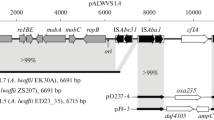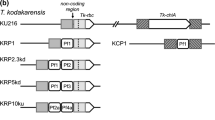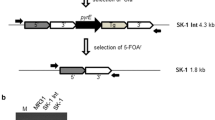Abstract
A newly isolatedPseudomonas plasmid coding for detoxification of the herbicide paraquat (Pqr) was characterized. AnEcoR1-generated fragment derived from the plasmid carrying the Pqr determinant was cloned intoEscherichia coli. Subsequent subclonings, followed by exonuclease III-mediated deletion analysis, localized the Pqr gene(s) to a 1.8-kb segment within a 4.2Pst1 subfragment. The cloning and apparent expression of the Pqr gene(s) inE. coli will enable its structural organization and function to be analyzed in detail.
Similar content being viewed by others
Literature Cited
Baldwin BC, Bray MF, Geoghegan MJ (1966) The microbial decomposition of paraquat. Biochem J 101:5
Boyer HW, Roulland-Dussoix D (1969) A complementation analysis of the restriction and modification of DNA inEscherichia coli. J Mol Biol 41:459–472
Calderbank A, Slade P (1988) Diquat and paraquat. In: Kearney PC, Kaufman DD (eds) Herbicides: chemistry, degradation and mode of action, vol 3. New York, Basel: Marcel Dekker, pp 501–540
Carr RJG, Bilton RF, Atkinson T (1985) Mechanism of biodegradation of paraquat byLipomyces starkeyi. Appl Environ Microbiol 49:1290–1294
Chung CT, Niemela SL, Miller RH (1989) One-step preparation of competentEscherichia coli: transformation and storage of bacterial cells in the same solution. Proc Natl Acad Sci USA 86:2172–2175
Duggleby CJ, Bayley SA, Worsey MJ, Williams PA, Broda P (1977) Molecular sizes and relationships of TOL plasmids inPseudomonas. J Bacteriol 130:1274–1280
Dunn NW, Gunsalus IC (1973) Transmissible plasmid encoding early enzymes of the naphthalene oxidation inPseudomonas putida. J Bacteriol 144:974–979
Frantz B, Chakrabarty AM (1986) Degradative plasmids inPseudomonas. In: Sokatch JR, Ornston LN (eds) The bacteria, vol 10. The biology ofPseudomonas. Orlando, Fla: Academic Press, pp 295–323
Funderbank HH, Bozarth GA (1967) Review of the metabolism and decomposition of diquat and paraquat. J Agric Food Chem 15:563–568
Gobius KS, Pemberton JM (1986) Use of the plasmid pULB113 (RP4:: Mini-mu) to construct a genomic map ofAeromonas hydrophila. Curr Microbiol 13:111–115
Grinsted J, Bennett PM, Higginson S, Richmond MH (1978) Regional preference of insertion of Tn501 and Tn801 into RP1 and its derivatives. Mol Gen Genet 166:313–320
Hanahan D (1983) Studies on transformation ofEscherichia coli with plasmid. J Mol Biol 166:557–580
Henikoff S (1984) Unidirectional digestion with exonuclease III creates targetted breakpoints for DNA sequencing. Gene 28:351–359
Jacoby GA (1979) Plasmids ofPseudomonas aeruginosa. In Doggett RG (ed).Pseudomonas aeruginosa: clinical manifestations of infection and current therapy. New York, San Francisco, London: Academic Press, pp 272–304
Lindow SE, Panapoulos NJ, McFarland BL (1989) Genetic engineering of bacteria from managed and natural habitats. Science 244:1300–1307
Miller JH (1972) Experiments in molecular genetics. Cold Spring Harbor, New York: Cold Spring Harbor Laboratory Press, pp 431–433
Pemberton JM (1983) Degradative plasmids. Int Rev Cytol 84:155–183
Pemberton JM, Vincent KM, Penfold RJ (1991) Cloning and heterologous expression of the violacein biosynthesis gene cluster fromChromobacterium violaceum. Curr Microbiol 22:355–358
Quigley NB, Reeves PR (1987) Chloramphenicol resistance cloning vector based on pUC9. Plasmid 17:54–57
Salleh MA, Tan LK, Osman G (1989) Plasmid-mediated resistance to paraquat in soil isolates ofPseudomons sp. Malays Appl Biol 18:1–8
Sambrook J, Fritsch EF, Maniatis T (1989) Molecular cloning: a laboratory manual, 2nd edn. Cold Spring Harbor, New York: Cold Spring Harbor Laboratory Press.
Sayler GS, Hooper SW, Layton AC, King JMH (1990) Catabolic plasmids of environmental and ecological significance. Microb Ecol 19:1–20
Smith SN, Lyon AJE, Sahid IB (1976) The breakdown of paraquat and diquat by soil fungi. New Phytol 77:735–740
Stanisich VA, Bennett PM (1986) The properties of hybrids formed between the P-group plasmid RP1 and various plasmids fromPseudomonas aeruginosa. Mol Gen Genet 146:217–223
Takahashi S, Nagano Y (1984) Rapid procedure for isolation of plasmid DNA and application to epidemiological analysis. J Clin Microbiol 20:608–613
Tucker BV, Pack DE, Ospenson JN (1967) Adsorption of bipyridylium herbicides in soil. J Agric Food Chem 15:1005–1008
WHO (1984) Environmental Health Criteria 39: paraquat and diquat. Geneva: World Health Organization
Wright KA, Cain M (1970) Microbial degradation of 4-carboxy-1-methylpyridylium chloride, a photolytic product of paraquat. Biochem J 118:52
Yanisch-Peron C, Vierra J, Messing J (1985) Improved M13 phage cloning vectors and host strains: nucleotide sequence of the M13mp18 and pUC19 vectors. Gene 33:103–119
Author information
Authors and Affiliations
Rights and permissions
About this article
Cite this article
Salleh, M.A., Pemberton, J.M. Cloning of a DNA region of aPseudomonas plasmid that codes for detoxification of the herbicide paraquat. Current Microbiology 27, 63–67 (1993). https://doi.org/10.1007/BF01570859
Issue Date:
DOI: https://doi.org/10.1007/BF01570859




